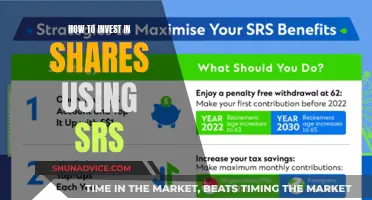
Drip investing, or DRIP, is a program that allows investors to reinvest their cash dividends into additional shares of the company's stock. This can be done through a formal program offered by a publicly traded company or through an arrangement set up with a brokerage or investment firm. DRIPs offer a way for investors to compound their returns and accumulate more shares over time. While DRIPs can provide benefits such as commission-free purchases and dollar-cost averaging, there are also tax implications and the risk of overexposure to a particular company or sector. Should you use drip investing? It depends on your financial goals and risk tolerance.
| Characteristics | Values |
|---|---|
| Definition | A dividend reinvestment plan |
| Acronym | DRIP |
| Description | A program that allows investors to reinvest their cash dividends into additional shares of the underlying stock |
| Benefits | Compounding returns, no commission, dollar-cost averaging, long-term gains, discounted share price |
| Drawbacks | Taxable income, inflexible reinvestment schedule, may lead to an unbalanced portfolio, reduced diversification |
What You'll Learn

Compounding returns
Here's an example to illustrate how DRIP investing can lead to compounding returns:
Let's say you own 100 shares in a company that pays a quarterly dividend of $0.50 per share. Your first dividend payment will be $50. If the company's shares are trading at $25 per share, with a DRIP, you will automatically receive two more shares, bringing your total to 102 shares. The next dividend payment will be based on this new share total, thereby compounding the growth of your investment. As the years go by, this compounding effect can lead to significant growth in your portfolio.
The power of compounding returns is that it allows your investment to grow exponentially over time. By reinvesting your dividends, you are able to accumulate more shares without having to invest additional capital. This, in turn, leads to larger dividend payments, which can then be reinvested to purchase even more shares. This cycle repeats and accelerates the growth of your investment.
Another benefit of DRIP investing is that it takes advantage of dollar-cost averaging (DCA). DCA is a technique that averages out the price at which you buy stocks as the market moves up or down. By investing a fixed amount at regular intervals, you avoid the risk of investing a large sum at the peak of the market. With DRIP investing, each dividend payment allows you to purchase shares at different price points, smoothing out the impact of market volatility on your investment.
It's important to note that DRIP investing may not be suitable for everyone. One of the main disadvantages is that it may not be ideal if you are looking to generate immediate income from your investments. Reinvesting your dividends means giving up access to a stream of investment income. Additionally, there are tax considerations, as dividends received through a DRIP are typically considered taxable income, even if they are reinvested.
Overall, DRIP investing can be a powerful tool for compounding returns and building wealth over the long term. However, as with any investment strategy, it is important to carefully consider your financial goals, risk tolerance, and tax implications before deciding if DRIP investing is right for you.
Acorn App: Investing Made Easy for Beginners
You may want to see also

Dollar-cost averaging
DCA is a useful strategy for those who don't have a lot of money to invest. It also helps to automate your financial decisions, so you don't have to worry about identifying the perfect time to buy.
A Dividend Reinvestment Plan (DRIP) is an example of DCA in action. With a DRIP, you can reinvest your cash dividends to purchase additional shares of the same stock automatically and commission-free. This allows you to accumulate more shares without having to pay a commission, and these additional shares will themselves pay dividends that can be reinvested.
DRIPs can be set up through an online broker or investment company, or directly through the company offering the DRIP.
Cash is Not King: Exploring Investment Alternatives
You may want to see also

Tax implications
Dividend Reinvestment Plans (DRIPs) have several tax implications that investors should be aware of.
Firstly, it is important to note that dividends paid into DRIPs are taxed as ordinary dividends, even when they are reinvested into purchasing more shares. This means that reinvested dividends are considered taxable income and must be reported in tax returns. For US-based investors, this is reported on a Form 1099-DIV, which details the amount to be declared.
The tax rate on reinvested dividends depends on whether they are classified as qualified or non-qualified dividends. Qualified dividends are taxed at the capital gains rate, which varies from 0% to 20%, depending on the investor's income bracket. To qualify as a qualified dividend, the investor must have held the stock for more than 60 days during the 121-day period that begins 60 days before the ex-dividend date. Non-qualified dividends are taxed as ordinary income, subject to the investor's usual income tax rate, which can be higher.
Additionally, when participating in a DRIP, it is crucial to understand how dividend reinvestments affect the cost basis and eventual capital gains tax. Each dividend reinvestment increases the total investment in a stock, altering the cost basis. This adjusted cost basis is essential for accurately calculating taxes on capital gains when the shares are sold.
Furthermore, if a DRIP is active in a non-retirement account, the dividend income is taxable and will be reported as if it were received in cash. To avoid this, investors can hold their DRIPs in tax-advantaged accounts, such as traditional Individual Retirement Accounts (IRAs) or 401(k)s, where investments grow tax-deferred. Alternatively, Roth IRAs and 401(k)s are tax-free, meaning that both investment growth and withdrawals are tax-exempt, provided certain conditions are met.
Finally, it is worth noting that DRIPs involving foreign stocks may have additional tax implications, such as withholding taxes by the country of origin, which must be considered when making investment decisions.
Should I Withdraw My Vanguard Investments?
You may want to see also

Discounted shares
Dividend Reinvestment Plans (DRIPs) are a way to grow your investments by reinvesting dividends. DRIPs allow investors to use their cash dividends to purchase additional shares of the underlying stock on the dividend payment date. This can be done through a formal program offered by a publicly traded corporation or by setting up an automatic reinvestment program through an online broker or investment company.
One of the main advantages of DRIPs is the ability to accumulate more shares without paying a commission. Many companies offer shares at a discount through their DRIP programs, typically ranging from 3 to 5% off the current share price. This discount, combined with no trading commissions, allows investors to lower their cost basis for owning a company's shares. As a result, DRIPs can help investors save money when buying additional shares compared to purchasing them on the open market.
Another advantage of DRIPs is the ability to take advantage of dollar-cost averaging (DCA). DCA averages out the price at which you buy stocks as they move up or down, helping to reduce the risk of investing. With each dividend payout, investors can acquire more and more shares, which can lead to larger payouts over time. This is known as the power of compounding.
However, there are also some disadvantages to consider when using DRIPs. One important consideration is that dividends reinvested through DRIPs are still considered taxable income and must be reported, even if they are held in a tax-advantaged account like an IRA or RRSP. Additionally, when investors want to sell their shares purchased through a company's DRIP program, they must sell them back to the company directly, rather than on the open market through a broker.
Overall, DRIPs can be a useful tool for investors looking to grow their investments over time and take advantage of compounding and dollar-cost averaging. However, it is important to carefully consider the potential disadvantages and tax implications before enrolling in a DRIP program.
Explore Alternative Investments Beyond Your Home
You may want to see also

DRIP eligibility
DRIP stands for Dividend Reinvestment Plan. It is a program that allows investors to reinvest their cash dividends into additional shares or fractional shares of the underlying stock on the dividend payment date.
To be eligible for DRIP, you need to have at least one DRIP-eligible security in your account. These are usually stocks or securities that pay dividends. The dividends are then reinvested to purchase more shares in the company, which is known as "dripping".
DRIPs are typically set up through an online broker or investment company, and they may have different eligibility requirements. For example, some DRIPs may require a minimum number of shares to participate in the plan. It is important to contact the company or broker to find out the specifics of their DRIP plan.
Additionally, DRIPs are not limited to whole shares, and fractional shares can also be purchased. This means that investors can reinvest their entire dividend, even if it is not enough to purchase a full share.
It is also worth noting that DRIPs are not limited to individual investors. Businesses and other organizations can also take advantage of DRIPs to reinvest their dividends and accumulate more shares over time.
How Much Cash Flowed from 2010 Investments?
You may want to see also
Frequently asked questions
Drip investing, or a Dividend Reinvestment Plan (DRIP), is a program that allows investors to automatically reinvest their cash dividends into purchasing additional shares of the company's stock. This strategy allows investors to compound their returns over time.
DRIPs offer a number of benefits for investors, including the ability to accumulate more shares without paying commissions, take advantage of dollar-cost averaging, and benefit from the power of compounding. DRIPs can also be set up to be automatic, saving investors time and effort.
Yes, there are a few potential downsides to consider. Reinvesting dividends may not be ideal if you are looking for income from your investments, as it requires giving up access to a stream of investment income. Additionally, dividends outside of a registered account will generally be taxed, which may require paying taxes out of pocket. DRIPs can also lead to overexposure to a particular company or sector, requiring portfolio rebalancing.
You can set up a DRIP through an online broker or investment company, or directly through the company offering the DRIP program. It is generally a straightforward process, but specific steps may vary depending on the broker or company.
The decision to use drip investing depends on your financial needs and goals. If you are looking for long-term growth and want to avoid paying commissions, DRIP investing could be a good option. However, if you prefer the steady income that some investments can provide, you may be better off taking your dividends in cash. It is always a good idea to consult with a financial planner or advisor to determine the best strategy for your situation.







